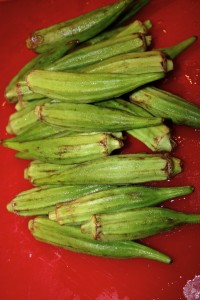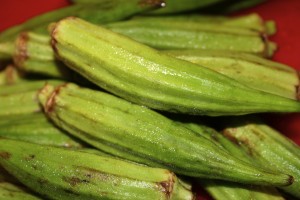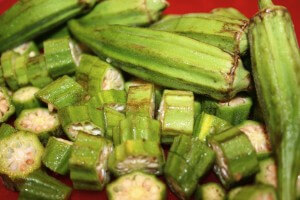Today I’m taking a Closer Look at Okra…not Oprah…Okra. You know its that thing they deep fry down South! If you’re not from the South you may never have really tasted or even seen Okra. My Southern mother has always talked about how she loves fried Okra, but I had never really tasted it or cooked with it for myself.
I can’t say I ever really even thought about using Okra in my cooking, until I ran across a recipe a couple weeks ago that called for it. Being the adventurous foodie that I am, I thought “yes, a new food to try.” I didn’t even know if I would be able to find it at my local supermarket, but sure enough it was there and on sale…even better! So, let’s take a Closer Look at this Southern favorite.
 What is Okra?
What is Okra?
Okra is a plant (crop) grown in tropical, warm climates. In fact, its a staple vegetable in hot, tropical regions. The edible part of the plant is the “fibrous fruit” or pod that shoots off the plants’ stalks. Inside each pod lies tons of small white seeds…don’t worry the seeds are really soft and edible. When you cut into each pod you’ll notice there’s a thick liquid that surrounds the seeds. Cook it and you’ll never notice that texture of the liquid or the seeds.
The pods are harvested off the plant before they’re fully matured and are eaten as a vegetable, most often cooked somehow in the preparation.
How to select the best Okra?
Look for small fresh, crisp, green pods that are free of mold and large spots. Once you get the pods home, store in the fridge and prepare while they’re still fresh.
What are the health benefits of Okra?
Okra is high in fiber, which is perfect for keeping your weight down and your digestion working properly. The combo of the fiber and thick liquid contained in the pods assist your body’s natural peristalsis, moving food through your intestines, preventing constipation.
These pods are loaded with anti-oxidants and vitamins A, K, C and folate. Okra is a great source of minerals as well, including iron, calcium, manganese, phosphorous, potassium and magnesium. Okra’s glycemic load is low (its low in carbs), meaning it won’t spike your blood sugar.
How do you prepare Okra?
Start by thoroughly washing the pods with cold water. For most preparation methods you’ll need to cut away the crown and tips and cut the pods into small sections. You can then batter and deep fry if you so choose. But, there are much healthier ways to prepare it like pan frying it with other veggies. Or try boiling it or adding it to stews. You can also pickle whole Okra pods. Can’t say I’ve ever had it pickled, but I’ve heard its delicious.
Stay tuned this week to see my recipe I made with Okra.
Resources:
http://www.nutrition-and-you.com/okra.html
http://nutritiondata.self.com/facts/vegetables-and-vegetable-products/2498/2


yay for okra! i know I love it fried and in succotash, but i’d love to know other ways to try it. i’ve saved a recipe to try that is rice, okra, and bacon crumbles…sounds interesting enough
my mom has made a lower fat version of doing it fried with a little cornmeal in olive oil. makes a good side dish.
can’t wait to see what you end up doing with it!
I’d love to know how your mom used cornmeal to fry it. Let me know.
Oh… maybe you will become a Southern cook after all. At least maybe you will acquire a Southern pallet. I feel so bad I never fed you fried okra. I really think we had it at Nanny & Papa’s and remember you would not eat it. So glad you are now. Love ya, Mom
Love it now!